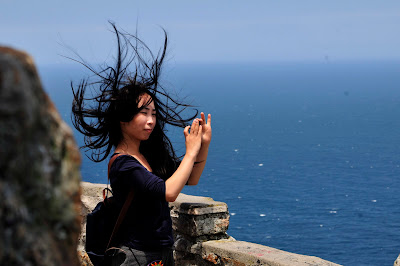WHIMSICAL CAPE
Sometimes it is nice not to explain, not to read, not to... but just to seat and to enjoy. March blogpost displays a series of scenes I recently captured traveling through West Cape, South Africa. Images which can be traced to Cape Town and West Cape area including the wineries around Stellenbosch, Franschooek townships, the coastal area east and west from Cape Town not to mention the sublime hills and curves along the Garden Route. Overall, covering nearly 3,000 kms of road and loose soil in dry, wet, hot, windy and fresh weather conditions. A strong climate in its own right - poignant on a motorbike! The adventure was certainly enticing to all senses in a truly 'road-movie' approach, in a style of the likes of Easy Rider, Lolita or Paris, Texas - no bookings, no fixed destination nor (asphyxiating) goals... but a marvelous whimsical interplay.
Amongst some of the visited locations included national parks, fishing villages and townships such as: Kaapstad, Boschendal, Paarl, Franschhoek, Riebeek Casteel, Moorreesbug, Hopefiel, Paternoster, Sommerset West, Strand, Hermanus, Betty's Bay, Cape Agulhas, Arnison, Knysna to mention just a few.
Enjoy,
GAM
[Melbourne 3-March-2012]
"Ci sono certe ossessioni della modernitá che non penso siano 'tout court' positive per il futuro. Sono, tra tante altre:
- La Velocitá. Tutto, assolutamente tutto, deve succedere piú - in fretta -, ansi immediatamente. Immediatamente deve succedere la nascita, consumo e morte di qualsiasi evento, di qualsiasi cosa prodotta.
- La Leggerezza. L'uomo deve eliminare la forza de gravitá, il peso. Tutto deve essere leggero, leggerissimo e se non é leggero deve 'sembrare' leggero. Tutto deve un po' volare. Un ingegnere molto famoso ha detto: É bello costruire sempre piú in alto.
- La Violenza. L'eroismo, il rischio mortale, l'astuzia, il furto e l'assassinio sono segni di forza, di mascolinitá, di vittoria.
I grattacieli all'orizzonte contengono velocitá, leggerezza, astuzia, futur e - perché no? - forse anche assassinio. Chi li abita?"
Ettore Sottsass, Foto dal Finestrino (Adelphi 2011)
"Photographically one year old. Having an incurable tendency very early in life of preferring the two-dimensional image to its three-dimensional counterpart, it was inevitable that I should discover the camera. Camera-eye has revealed a new visual sphere for my habitation; much that was before visually incomprehensible has become, in the presence of the camera, significant. A divining rod finding its own peculiar water, with myself a passive divider. There is, of course, much still to be divined".
Edwin Smith in Robert Elwall, "Evocations of Place The Photography of Edwin Smith" (Merrell 2007)
"This conception of photography as an exhilarating voyage of discovery into the teeming richness of the visual world, which could be divided in the ordinary as well as the extraordinary, and of the photographer as the unassuming recorder and celebrant of this world, was to remain one of the guiding principles of Simith's camera work for nearly forty years"
Robert Elwall, "Evocations of Place The Photography of Edwin Smith" (Merrell 2007)
"My photography is a reflection which comes to life in action and leads to meditation. Spontaneity - the suspended moment - intervenes during action, in the viewfinder. A reflection on the subject preceded it. A meditation on finality follows it, and it is here, during this exalting and fragile moment, that the real photographic writing develops, sequencing the images. For this reason a writer's spirit is necessary to this enterprise. Isn't photography 'writing with light'? But the difference that while the writer possesses his word, the photographer is himself possessed by his photo, by the limit of the real which he must transcend so as not to become its prisoner"
ABBAS, The First 45 Years in Photography (2011)
"For almost 45 years I have roamed the world, in search of images of upheaval; initially political and social, then later, religious. Retrospectives are the best done when the photographer is no longer around - there will be no surprises then...."
ABBAS, The First 45 Years in Photography (2011)
"Casi todos los personajes del Road Movie experimentan esta misma búsqueda, ya sea la búsqueda de otros o la búsqueda de si mismos a través de algo inusitado o de alguien dispuesto a compartir el trayecto; los ejemplos se hacen extensivos a los raros presonajes de un David Lynch o a los caprichos de la Lolita de Kubrik o a cualquier otro desalineado que encuentra su corazón de existir en el Road Movie, pero lo que más importa es que el cine de carretera vuelve a ser espacio abierto que se extiende sin limites, que cobija a seres extraños y que presenta al espectador un desfile de figuras arquetípicas de la cultura del camino porque solo en el tienen cabida los desbaratados sueños, el impulso vital del movimiento, y en suma, el reencuentro con la parte olvidada de cada ser".
Paulina Aranda-Mena, El Espacio Fílmico (2002)
"HOMO SAPIENS: I have always looked at humans as members of a large tribe: the Homo sapiens. I presume this is why an African emperor on his coronation day cohabits with a Nobel prize-winner for literature; a world heavyweight boxing champion with a famous fashion designer; an Iranian film director with a fashion model."
ABBAS, The First 45 Years in Photography (2011)
"Qualche volta la luce non é quantitá di lux; qualche volta la luce é il cielo completo che precipita nella stanza".
Ettore Sottsass, Foto dal Finestrino (Adelphi 2011)
"The traveller never arrives"
Copyright © Guillermo Aranda-Mena 2012


























































